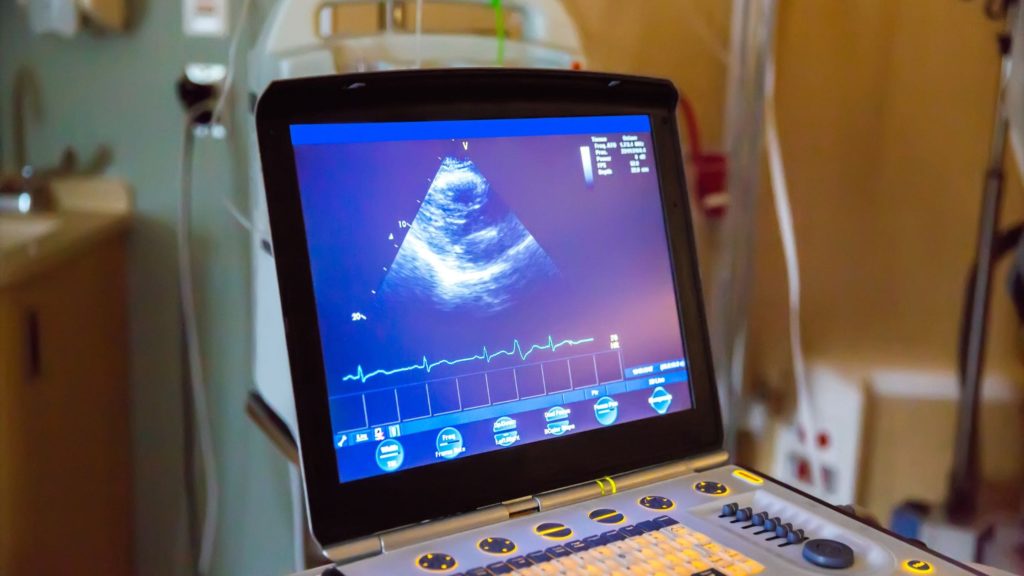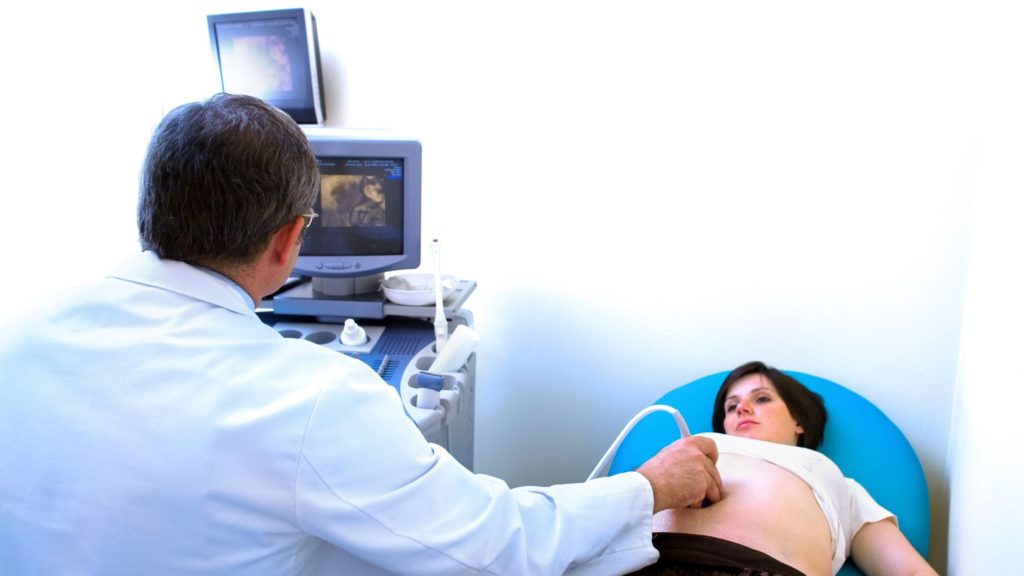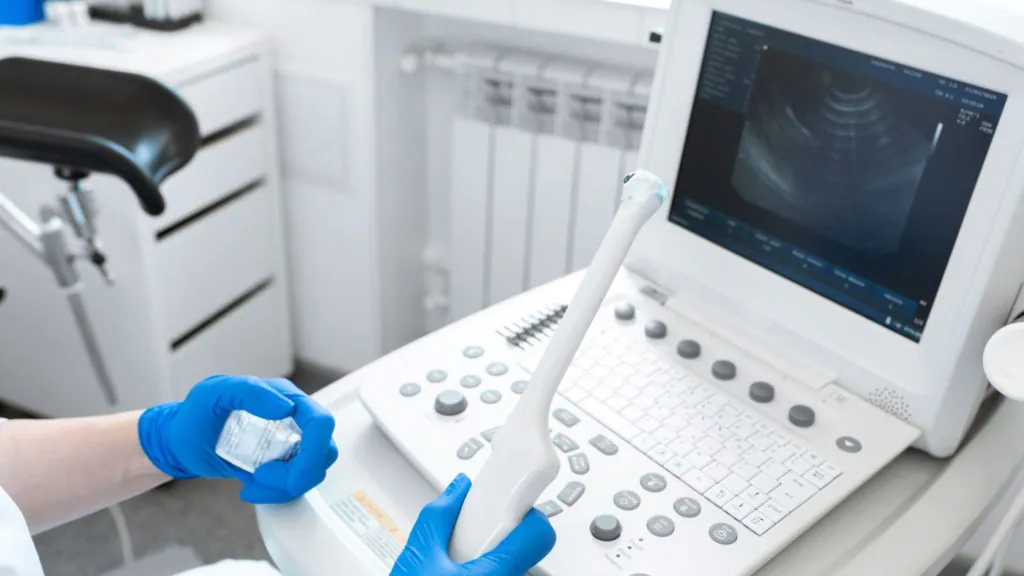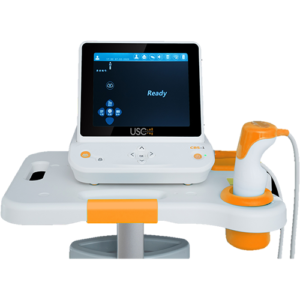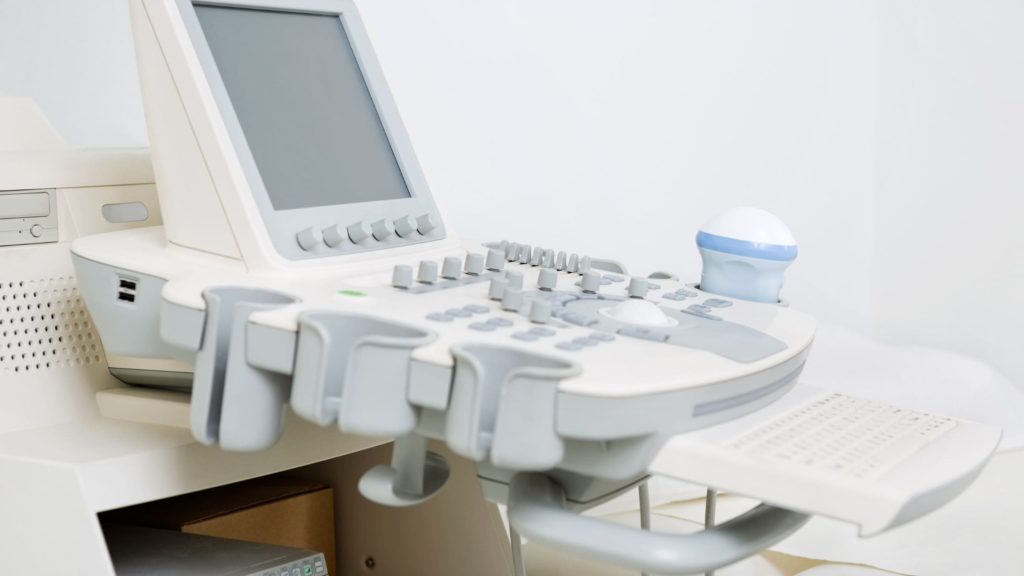Ultrasound machines have benefited in recent years from the advances in medical technology. There are now dozens of different types of ultrasound machines on the market, each offering various services and features.
Such a vast choice can be challenging. If you want to purchase an ultrasound system, understanding the various options should make the decision easier.
So, how many types of ultrasound machines are there? There are 4 main types. Let’s examine and explain each one.
What Are The 4 Main Types of Ultrasound Machines?
There are 4 main types of machines that utilize ultrasound technology. Which one you choose depends on the types of tests you need to perform, the type of ultrasound image you require, and the type of equipment available.
Here are the main ultrasound machine types:
2D Ultrasound Machines
These are the most common type and produce two-dimensional images that are cross sections of the tissue being scanned.
Benefits
- Real-time imaging
- Radiation-free process using high-frequency sound waves
- Suitable for use at any point during pregnancy
Common uses
- Diagnostic ultrasound
- OB/Gyn procedures
- Assist anesthesiologists in various procedures
- Cardiology: echocardiography to diagnose heart conditions
- Vascular imaging
3D Ultrasound Machines
Three-dimensional ultrasound machines scan tissue cross sections from a variety of angles. The data is then reconstructed to produce a three-dimensional image.
Benefits
- Faster examinations and shorter patient waiting times
- Better quality images
Common uses
- Obstetrics
- Gynecology
- Fetal ultrasound cardiac
- Internal medicine
- Ophthalmology
- Musculoskeletal
4D Ultrasound Machines
The fourth dimension that these ultrasound machines take advantage of is – time. A dedicated computer creates the most realistic images possible within a medical facility.
Benefits
- Produces realistic images that can be very rewarding for expectant parents
- Able to reveal small abnormalities not detected with 2D ultrasound
- Images appear to be moving
- Highest quality color images
Common uses
- OB/GYN scans
- Breast exams
- Gynecology
- Internal medicine
- Urology
- Musculoskeletal
Doppler Ultrasound Machines
Doppler ultrasound machines are used for blood flow measurements and evaluating pressure within blood vessels. Traditional 2D and 3D ultrasound machines are unsuitable for this kind of examination.
High-frequency sound waves bounce off the blood cells as they move, and the machine records changes in the frequency of the sound waves. This is then converted into a visual representation of the blood vessels. The speed the blood is flowing and in what direction can be seen from examining the images.
Benefits
- Can detect conditions that are blocking or restricting blood flow
- Simple procedure
- No known risks
Common Uses
- Diagnosing cardiovascular diseases
- Detecting blood clots, blocked and bulging arteries
- Monitoring heart rate and blood flow measurements
Color Doppler Ultrasound
In a color Doppler ultrasound machine, a computer is used to change sound waves into different colors that show the speed and direction of blood flow in real-time.
Power Doppler Ultrasound
This is a newer type of color Doppler ultrasound that provides a more detailed image of blood flow. However, it cannot show the direction of blood flow.
Spectral Doppler Ultrasound
This machine shows blood flow measurements as a graph rather than color pictures. It can show whether a blood vessel is blocked and how serious the blockage is.
What are the Uses and Applications of Different Ultrasound Machines?
The wide range of ultrasound machines available means that they can meet the differing needs of clinics, hospitals, and medical professionals. Below you’ll find the most common ultrasound machines available and what they can be used for.
Basic Ultrasound Machine
This is the most common type that typically produces two-dimensional images. The images are made using high-frequency sound waves that bounce off the internal structures of the body. The sound waves are received by a transducer which then creates the image.
Applications
- Listening to babies’ heartbeat during a sonogram
Pelvic Ultrasound Imaging
Pelvic ultrasound imaging is most commonly used for monitoring the health of a fetus or embryo during pregnancy. However, there are a number of other uses.
Applications
- Examining the uterus, bladder, ovaries, and prostate gland
- Diagnosing conditions such as abnormal bleeding, menstrual problems, pelvic pain, uterine fibroids, uterine and ovarian cancers
Transvaginal Ultrasound
A transvaginal ultrasound scanner is used to see what’s going on inside a woman’s vagina. The examination takes place with the patient lying on their back with their feet in stirrups. A transducer is inserted into the vagina and moved around to capture images from different angles.
Uses:
- Detecting abnormalities
Transrectal Ultrasound
A transrectal imaging scanner is used to check inside the patient’s rectum. A transducer is inserted so that sound waves can travel to the prostate. The patient lies down for the examination on their left side.
Uses:
- Detecting abnormalities
Obstetric Imaging
Obstetric imaging machines use sound waves to determine the condition of a pregnant woman and her fetus or embryo. The patient lies on their back or side, and they have to expose their lower abdominal area. The sonographer guides a transducer over the area. There is minimal discomfort.
Uses:
- Establishing the presence of a living fetus or embryo
- Estimating the pregnancy age
- Diagnosing congenital abnormalities
- Evaluating the position of the fetus
- Determining the location of the placenta
Breast Ultrasound Imaging
This type of ultrasound machine is specifically for scanning breast tissue. There is no radiation, so this is a preferred method for detecting breast cancer. The machine can detect the smallest abnormality. Doppler signals are also used to monitor blood flow.
Uses:
- Detecting early signs of breast cancer
- Ultrasound-guided biopsies for laboratory testing
- Monitoring blood flow
Abdominal Ultrasound Imaging
Abdominal ultrasound imaging machines are used to obtain images and examine internal organs and internal tissues to help diagnose a range of conditions or assess the damage caused by illness. It provides real-time ultrasound images of the liver, spleen, pancreas, bladder, gallbladder, and kidneys.
Uses:
- Guiding procedures such as needle biopsies
- Determining the source of abdominal pain
- Identifying the cause of an enlarged abdominal organ
- Doppler ultrasound models can evaluate blood flow, build-up of plaque, or congenital malformation
Kidney Imaging
A kidney or renal ultrasound machine uses sound waves to make images of the kidneys, bladder, and ureters.
Uses:
- Assessing the location, shape, and size of the kidneys and any related structures, such as the bladder and ureters
- Detecting tumors, cysts, obstructions, abscesses, infection, and fluid collection around and within the kidney
- Detecting calculi (stones) in kidneys and ureters
- Assisting with needle placement used in a biopsy of the kidneys or to drain fluid from an abscess or cyst
- Determining blood flow to the kidneys
- To evaluate a transplanted kidney
Uterus Imaging
This type of ultrasound machine looks at a woman’s uterus, tubes, ovaries, pelvic area, and cervix. The ultrasound probe is placed inside the vagina during the test.
Uses:
- Examining the shape, size, and position of the uterus and ovaries
- Measuring the length and thickness of the cervix
- Monitoring the blood flow through the various pelvic organs
- Identifying whether there are any changes to the shape of the bladder
- Diagnosing benign growths
- Endometriosis diagnosis
- Checking the heartbeat of a fetus
Musculoskeletal (MSK) Pain Management
An MSK pain management ultrasound machine creates images of various body parts using high-frequency sound waves. These images can be used to assess and diagnose musculoskeletal and cardiac issues.
Uses:
- Checking the thickness and quality of cartilage
- Poor joint function
- Abnormalities in bone marrow
- Ligament and tendon tears
- Assessing structural injuries
- Monitoring abdominal and other MSK-pain-management programs
- Helping guide biopsies, joint, and soft tissue injections
- Provision of vascular access
Carotid & Abdominal Aorta Imaging
This type of ultrasound machine provides a noninvasive and fast way of identifying blockages in neck arteries leading to the brain. Primarily, it is used for evaluating an aneurysm. This is an enlargement of the aorta, generally because of atherosclerotic disease.
Liver
This type of examination can determine the shape, size, and functioning of the liver. It can also detect tumors.
Vascular/Thyroid Ultrasound
Vascular ultrasound machines can be used for the analysis of blood flow through a patient’s veins and arteries.
Thyroid
If a doctor suspects the thyroid glands and overactive or underactive, a thyroid ultrasound examination can be used to check. Also it checks for cysts and nodules.
Renal
This type of examination can determine the shape, size, and function of this organ. It’s also possible to use it to detect tumors, cysts, and kidney stones.
Shared Service Ultrasound
These are ultrasound machines that have been upgraded and can perform cardiology examinations in addition to general ultrasound examinations.
Applications
- Obstetrics
- Gynecology
- Vascular
- Urological
- Musculoskeletal
- Abdominal
- Small parts
Console Ultrasound Imaging
This is a transportable ultrasound machine on wheels. Generally, they measure no more than two feet by two feet.
Applications
- Obstetrics
- Gynecology
Portable Ultrasound
As the name implies, this is a portable ultrasound machine. It might consist of a transducer, a probe, and a digital device such as a smartphone, tablet, or computer.
Uses:
- Small clinics where space is a premium
- Handling high numbers of patients
Veterinary
Veterinary ultrasound machines are for use on animals. The examination needs to be more accurate because animals and their internal organs tend to be smaller than humans.
Uses:
- Visualizing internal organs and tissues of animals
- Examining lungs, heart, abdomen, and reproductive organs
- Detecting and treating animal pregnancies
- Diagnosing internal conditions or injuries
- Performing sonograms
- Diagnosing tumors and cancer
- Helping guide medical procedures and biopsies
What are the Main Ultrasound Machine Brands?
Some ultrasound brands offer general imaging systems, and others supply highly specialized ultrasound technology. Here are the top ultrasound brands:
Alpinion
Alpinion Ultrasound Systems is a company that focuses on front-end ultrasound technology and acoustic engineering to deliver ultrasound machines of the highest quality. Popular models from this brand include X-Cube, E-Cube, and Alpinion Minisono.
Philips
Philips is a well-known manufacturer of ultrasound machines that can be used for various applications, including vascular, cardiology, OB/GYN, and general imaging. Some machines can perform several applications, such as the portable CX50, the Affiniti 70, and the Epiq 5.
Siemens
Siemens has an excellent reputation for producing many popular ultrasound machines, including its most well-known S-series: the S1000, S2000, and S3000. HELX Touch versions of these models are also now available.
Canon
Formally known as Toshiba, this brand provides machines with excellent image quality and a range of technologies. The most popular series include Xario, Viamo, and Aplio. The Viamo series are portable machines, while the others are more standard.
Mindray
Mindray Zonare is a brand that offers a wide range of systems for a range of specialties, including general imaging, veterinary, cardio-vascular, and OB/GYN.
Some of the latest models include the Mindray MX7, the Mindray Z60, and the Mindray DC70 X-Insight.
Samsung
Features that make Samsung ultrasound machines stand out include ergonomic and intuitive design, reliability, ease of use, and optimized workflows. Popular models include the RS80a, HS70A, HS50, and HS60.
Sonosite
Sonosite is an industry innovator and the leader in portable and handheld imaging machine design. It is proud to inform potential customers that it has sold more than 40,000 systems in the last couple of decades. Some popular models include the exclusive Extreme Definition Imaging (XDI), the X-Porte, the MicroMaxx, and the Sonosite iVIZ.
GE
GE has been an excellent provider of ultrasound machines for many years. They offer a range of popular machines, including Logiq, Vivid, and Voluson. The Voluson series of machines focus on women’s health, while the GE Logiq series is more of a selection of general imaging ultrasound machines. For cardiovascular imaging, the Vivid line comes out on top.
How Much Do Different Types of Ultrasound Machines Cost?
The actual cost of an ultrasound machine can vary considerably depending on several factors such as the model, condition, and age.
Prices can range from a few hundred dollars to several thousand.
Check our guide for more information on how much ultrasound machines cost.
Factors to Consider When Choosing an Ultrasound Machine
Ultrasound machines have a range of functions, many of which might not be required for your particular application. Knowing what to look for when buying an ultrasound machine is very important. It means you can stick to a budget, cut out the frills, and only pay for what is absolutely necessary.
Some of the most important factors to consider when buying an ultrasound machine are:
Image Quality
Are you looking for a new or used ultrasound machine for better imaging? Then image quality and image-enhancing features should be a priority. At the end of the day, if the quality of the images isn’t clear enough, you won’t be able to provide a good level of patient care.
Workflow
Exam automation is a feature worth considering because it offers standardization regardless of who performs the exam. It can also help to reduce the number of repeat exams and unnecessary ultrasound testing.
Ease of Use
An easy-to-use machine is essential in Point-of-Care environments such as Critical Care, Urgent Care, and Emergency Departments. When users can rapidly triage and diagnose, everyone benefits.
When the ultrasound machine is easy to use, images can be captured quickly, and more patients can be helped.
Ergonomics
When a machine is used all day long, it must be ergonomic for those using it. A high percentage of sonographers experience pain related to their work.
When looking for an ergonomic ultrasound machine, consider how easy it is to move around and whether the monitor is articulated so it can be adjusted. Is the ultrasound system for standing or seated use? How many transducer ports are there? Are there any features to prevent dragging, tripping hazards, or cable fatigue?
Ownership Costs
Health organizations are under increased pressure to provide care at the lowest possible cost. When checking the price of an ultrasound machine, you must look at the total system cost over its lifespan. Don’t overlook the cost of service, technology upgrades, training, and system warranty.
Portability
A portable ultrasound machine can be effortlessly moved around and has a small footprint. You’ll also need to consider how long a system can run on battery power and the time it takes to boot up the system.
Warranty
Always check the warranty coverage, how easy parts can be obtained, and what the servicing requirements of a machine are.
Advanced Capabilities
Look for the quantification tools and features you will use the most. It may be beneficial to look for a system that can accept new technologies or functionalities later, to meet your changing ultrasound needs.
Technology Updates
As we all know, technology is constantly changing, so you want to ensure your ultrasound machine won’t be technologically obsolete in just a few years. Software fixes, ultrasound updates, and various enhancements will cost extra but could be worth the investment in the long run.
Trusted Partner
Having a partner that is there when you need them is priceless. When you’re buying an ultrasound machine, look for a vendor that offers support and servicing.
USC Ultrasound, for example, offers a wide selection of new and used ultrasound machines. In addition, there is tech support, OEM services, repair, and diagnostic services, and a USC and Me app.
Conclusion
Imaging equipment, especially ultrasound, is widely used in most medical centers. Because they use sound waves rather than radiation, they are considered much safer than any other diagnostic radiology machine. As well as being used as a diagnostic tool, different types of ultrasound can also be used as therapeutic tools.
In recent decades, many technological advancements have led to improvements in the performance and results of medical equipment. Now you know more about the vast range of options and the different types of ultrasound equipment, you’re better informed and can make the best decision.







